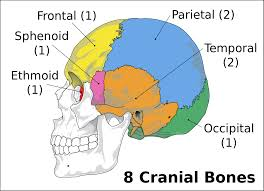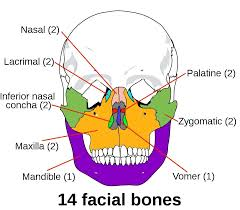Skull Bones List: Cranial and Facial Structure Made Simple
The human skull is a fascinating structure that protects the brain, anchors important muscles, and houses critical sense organs. Often, students wonder how many bones in the cranium they have or want to discover detailed skull bone names. In total, the skull consists of 22 bones (excluding the 6 tiny ear bones), which can be classified into 8 cranial bones and 14 facial bones. This guide presents each group of bones clearly, highlights the 7 functions of the skull, and includes extra learning resources to make your study more interactive and comprehensive.
The Skull at a Glance
Total Bones: 22 bones (without ear ossicles), firmly joined together except for the mandible (lower jaw).
Ear Bones (Auditory Ossicles): Additional 6 bones (2 each of the malleus, incus, and stapes) often listed separately.
Cartilage & Ligaments: Present to connect and support various structures of the skull.
The 8 Cranial Bones
There are the 8 cranial bones (neurocranium) that form the vault protecting our most vital organ:

Frontal (1): Forms the forehead and the roof of the eye sockets.
Parietal (2): Located on the sides and top of the skull. Joined together along the sagittal suture.
Temporal (2): Found beneath the parietal bones, each temporal bone supports the structures of the ear and has the mastoid process.
Occipital (1): Sits at the back and base of the skull, containing the foramen magnum (large opening) through which the spinal cord passes.
Sphenoid (1): A butterfly-shaped bone at the base of the skull, bridges the cranial and facial regions.
Ethmoid (1): A spongy bone located between the eyes, forming part of the nasal cavity and the orbits (eye sockets).
Collectively, these skull bones protect the brain, house some sense organs, and anchor muscles related to the head and neck.
The 14 Facial Bones
The facial bones form the front framework of your skull, supporting your facial structures, teeth, and cavities. These include:

Maxilla (2): Upper jaw bones. Each maxilla also forms part of the nose and eye sockets.
Mandible (1): The only moveable skull bone, forming the lower jaw used for chewing and speaking.
Nasal (2): Small rectangular bones form the bridge of the nose.
Lacrimal (2): Tiny, delicate bones located in the inner corner of each orbit, helping form the tear ducts.
Zygomatic (2): Cheekbones, contributing to the orbits’ shape and facial contour.
Palatine (2):L-shaped bones forming the posterior part of the hard palate and nasal cavity.
Inferior Nasal Concha (2): Curved bones within the nasal cavity, aiding airflow and filtration.
Vomer (1):A thin, flat bone forming the lower portion of the nasal septum.
These facial bones help shape your features, support muscles for expression and hold your teeth in place.
Ear Ossicles (Not Counted in the Main 22)
Although they are not included in the main 22 skull bones, the ear contains three paired auditory ossicles, crucial for hearing:
Malleus (2)
Incus (2)
Stapes (2)
If you include these 6 tiny bones in your total, the skull count goes up to 28.
Also, read Human Skeletal System
7 Function of the Skull
The skull is not just a rigid box; it performs a variety of essential functions. Here are the 7 function of the skull to help you understand its significance:
Protection of the Brain – Safeguards the delicate nervous tissues.
Supports Sense Organs – Houses organs for sight, smell, hearing, and balance.
Enables Facial Expressions – Provides attachment points for muscles that shape our facial expressions.
Facilitates Chewing & Speech – The mandible and maxilla help with mastication and articulate speech.
Maintains Facial Structure – Defines the unique contours of the face.
Assists in Breathing – Forms passages for air intake through the nasal cavity.
Attachment for Head & Neck Muscles – Allows movement of the head and support for posture.
Sutures and Growth
Skull Sutures: The cranial bones are joined by fibrous joints called sutures (e.g., coronal, sagittal, lambdoid), which fuse over time.
Fontanelles: In infants, the skull bones are not fully fused, leaving soft spots called fontanelles that allow the skull to expand as the brain grows.
Fun Task: Map Your Own Skull
Mirror Activity: Stand in front of a mirror and gently touch the bony landmarks on your face and head (forehead, cheekbones, jaw hinge).
Label It: Try labelling these regions on a printed skull diagram (download one from Vedantu’s Anatomy Resources) and identify which bones are cranial vs facial bones.
This simple activity helps you connect what you learn in theory to the actual contours of your own skull!
Quick Quiz: Test Your Understanding
Question 1: How many bones form the cranium portion of the skull?
Question 2: Which is the only movable bone in the skull?
Question 3: Name any two bones that help form the nasal septum.
Question 4: What are the small bones of the ear called collectively?
Question 5: Give one function of the sphenoid bone.
Check Your Answers
8 cranial bones
Mandible
Ethmoid and Vomer
Auditory ossicles (Malleus, Incus, Stapes)
It provides a central base, articulating with multiple cranial and facial bones, contributing to the orbits and nasal cavity


FAQs on 22 Bones of the Skull: Complete Student Guide
1. What are the 22 bones that make up the human skull?
The human skull consists of 22 bones, which are divided into two main groups: the 8 cranial bones and the 14 facial bones. The cranial bones protect the brain and include the frontal, parietal (2), temporal (2), occipital, sphenoid, and ethmoid bones. The facial bones form the structure of the face and include the mandible, maxilla (2), zygomatic (2), nasal (2), lacrimal (2), palatine (2), vomer, and inferior nasal conchae (2).
2. What are the primary functions of the human skull?
The primary functions of the human skull are:
- Protection: It forms a rigid, bony case that surrounds and shields the delicate brain from injury.
- Structural Framework: It provides the fundamental shape and structure for the head and face.
- Muscle Attachment: It serves as an anchor point for the muscles responsible for chewing (mastication) and facial expressions.
- Housing Sensory Organs: It contains and protects the special sensory organs for sight, sound, smell, and taste.
3. What is the main functional difference between cranial and facial bones?
The primary functional difference lies in their main purpose. Cranial bones (the neurocranium) are primarily responsible for forming the protective vault that encloses the brain. Their main job is safeguarding this vital organ. In contrast, facial bones (the viscerocranium) provide the structural framework of the face, support the teeth, and form the cavities for the eyes and nose, playing a key role in sensory functions, breathing, and eating.
4. Why is the mandible the only freely movable bone in the skull?
The mandible, or lower jaw, is unique because it forms a synovial joint known as the temporomandibular joint (TMJ) with the temporal bone of the cranium. This type of joint is highly mobile, allowing for the complex movements required for chewing and speaking. All other bones in the adult skull are interlocked by immovable fibrous joints called sutures, which make the rest of the skull a rigid structure.
5. Why is the total number of skull bones sometimes cited as 28 or 29, instead of 22?
This discrepancy arises from how different bones associated with the head are counted. The standard count of 22 bones refers strictly to the cranial and facial bones. The higher count of 28 includes these 22 bones plus the six auditory ossicles (malleus, incus, and stapes in each ear) located within the temporal bones. Sometimes, the count is 29, which also includes the hyoid bone in the neck, though it does not directly articulate with any other skull bone.
6. How do sutures and fontanelles in the skull differ, and what is their importance?
Sutures and fontanelles are both critical to skull development but serve different roles. Fontanelles are the soft, membranous gaps found between the cranial bones in an infant. Their importance is twofold: they allow the skull to compress safely during birth and accommodate the rapid growth of the brain. Sutures are the immovable, fibrous joints that form after the fontanelles close and the skull bones fuse together. In adults, their importance is to provide the skull with its characteristic strength and rigidity.
7. Which eight bones form the cranium?
The cranium, which encloses the brain, is formed by eight bones. These are: one frontal bone (forehead), two parietal bones (top and sides), two temporal bones (lower sides), one occipital bone (back), one sphenoid bone (forms part of the base), and one ethmoid bone (forms part of the nasal cavity and orbits).
8. What is the significance of the foramen magnum in the occipital bone?
The foramen magnum is a large opening located at the base of the occipital bone. Its primary significance is that it serves as the crucial passageway connecting the brain to the spinal cord. The brainstem passes through this opening to become the spinal cord, making it a vital connection point for the central nervous system.










